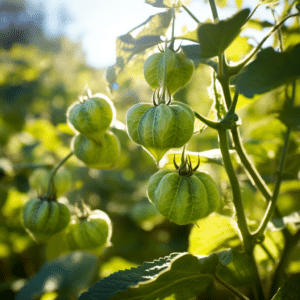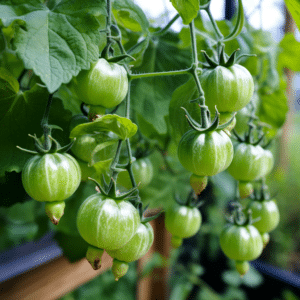Tomatillos, also known as Mexican husk tomatoes, are a staple in many traditional Mexican dishes. They are prized for their unique flavor, which can be described as tart, zesty, and slightly sweet. Growing tomatillos in your own garden can be a rewarding experience, providing you with a fresh supply of this versatile ingredient. This guide will cover everything you need to know about growing tomatillos, from choosing the right variety to harvesting and storing your crop.
Understanding Tomatillos

Before you start planting, it’s important to understand what tomatillos are and what makes them unique. Unlike regular tomatoes, tomatillos are encased in a papery husk and are usually harvested when they’re still green. They are a member of the nightshade family, which also includes tomatoes, peppers, and eggplants.
Tomatillos are a warm-season crop, which means they thrive in temperatures between 75 and 85 degrees Fahrenheit. They are also self-incompatible, which means you need to plant at least two plants for cross-pollination to occur.
Choosing the Right Variety
There are several varieties of tomatillos available, each with its own unique characteristics. The most common variety is the green tomatillo, which is used in traditional Mexican dishes like salsa verde. However, there are also purple and yellow varieties, which can add a splash of color to your garden and your dishes.
When choosing a variety, consider your climate and your culinary needs. Some varieties are more tolerant of cold or heat than others, and some have a sweeter or more tart flavor. Research different varieties and choose the one that best suits your needs.
Planting Tomatillos
Once you’ve chosen your variety, it’s time to start planting. Tomatillos can be started from seeds or transplants. If you’re starting from seeds, you’ll need to start them indoors 6 to 8 weeks before the last expected frost date. If you’re using transplants, you can plant them directly in the garden after the danger of frost has passed.
Tomatillos prefer well-drained soil with a pH between 6.0 and 7.0. They also need full sun, so choose a location that gets at least 6 hours of direct sunlight each day. Plant your tomatillos 2 to 3 feet apart to give them plenty of room to grow.
Starting from Seeds

If you’re starting from seeds, begin by filling a seed tray with a seed-starting mix. Plant the seeds 1/4 inch deep and keep the soil moist but not waterlogged. Place the tray in a warm location, such as on top of a refrigerator or near a heat vent. The seeds should germinate in 7 to 14 days.
Once the seedlings have two sets of true leaves, you can transplant them into individual pots. Continue to keep the soil moist and provide plenty of light. When the danger of frost has passed, you can harden off the seedlings by gradually exposing them to outdoor conditions over a period of a week or two.
Planting Transplants
If you’re using transplants, dig a hole that’s deep enough to accommodate the root ball. Place the transplant in the hole and backfill with soil, firming it gently around the base of the plant. Water thoroughly after planting.
For the first few weeks after planting, keep the soil consistently moist. Once the plants are established, you can reduce watering to once a week, or whenever the top inch of soil feels dry to the touch.
Caring for Tomatillos
With the right care, your tomatillos should start producing fruit in 75 to 100 days. Regular watering, feeding, and pruning can help ensure a healthy, productive crop.
Tomatillos are heavy feeders, so apply a balanced fertilizer every 4 to 6 weeks during the growing season. They also benefit from regular pruning. Remove any branches that are touching the ground to prevent disease, and pinch off the tips of the branches to encourage bushier growth.
Dealing with Pests and Diseases

Like any garden plant, tomatillos can be affected by pests and diseases. Common pests include aphids, tomato hornworms, and flea beetles. You can control these pests by hand-picking, using insecticidal soap, or introducing beneficial insects like ladybugs and lacewings.
Common diseases include blight, powdery mildew, and verticillium wilt. To prevent these diseases, practice good sanitation by removing any diseased plant material and avoid watering from overhead, which can spread disease spores.
Harvesting and Storing Tomatillos
Tomatillos are ready to harvest when the husk splits and the fruit fills the husk. The fruit should be firm and the color should match the variety you planted. To harvest, simply twist the fruit off the vine.
Once harvested, tomatillos can be stored in the refrigerator for up to two weeks. For longer storage, you can freeze them or make them into salsa or sauce and can it. Just remember to remove the husks and rinse off the sticky residue before using or storing your tomatillos.
Conclusion
Growing tomatillos can be a rewarding experience, providing you with a fresh supply of this versatile ingredient. With the right care and attention, you can enjoy a bountiful harvest of tomatillos from your own garden. So why not give it a try? You might just discover a new favorite crop.